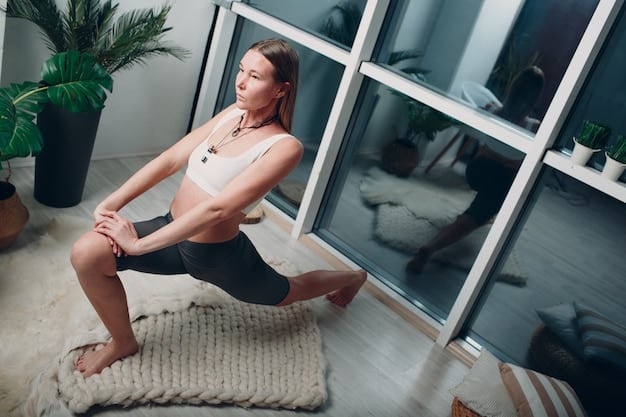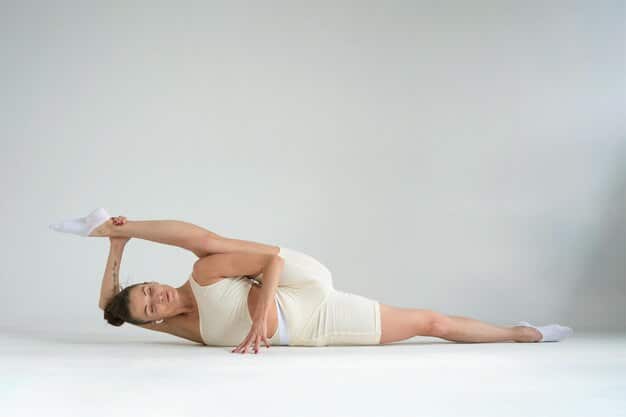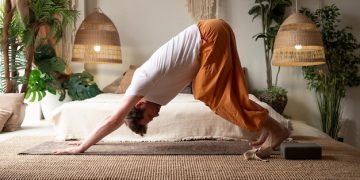Prevent Back Pain: 5 Daily Stretches Recommended by US Physical Therapists

Preventing back pain effectively involves incorporating specific daily stretches, a practice widely endorsed by physical therapists across the U.S., offering a proactive approach to maintaining spinal health and flexibility while reducing discomfort.
For many, back pain is not merely an inconvenience; it can be a debilitating constant. While chronic conditions often require medical intervention, a significant portion of back discomfort can be mitigated or even prevented through consistent, targeted daily routines. This article explores how to prevent back pain: 5 daily stretches recommended by US physical therapists, offering a proactive approach to maintaining a healthy, flexible spine and improving overall well-being. By integrating these simple yet powerful movements into your daily life, you might find significant relief and long-term prevention.
Understanding the Root Causes of Back Pain and Why Stretching Helps
Back pain, a common ailment affecting millions globally, particularly in the US, stems from a variety of factors. Sedentary lifestyles, poor posture, muscle imbalances, and even stress can contribute significantly to its onset. Our modern lives often involve prolonged sitting, whether at a desk for work, commuting, or relaxing at home. This can lead to weakened core muscles, tightened hip flexors, and strained back muscles, setting the stage for discomfort.
Physical therapists emphasize that the human body is designed for movement. When movement is restricted, the intricate network of muscles, ligaments, and discs supporting the spine can become stiff and less resilient. This is where targeted stretching plays a crucial role. Stretching helps to improve flexibility, increase blood flow to the muscles and tissues, and enhance range of motion. By regularly engaging in specific stretches, you can counter the negative effects of inactivity and promote better spinal alignment.
The Biomechanics of Back Pain
Understanding the biomechanics of how our spine works can illuminate why certain activities lead to pain and how stretching intervenes. The spine is a complex structure of vertebrae, discs, nerves, and muscles. When one component is compromised, it can affect the entire system. For instance, tight hamstrings can pull on the pelvis, flattening the natural curve of the lower back and placing undue stress on the lumbar spine. Similarly, weak abdominal muscles provide less support for the trunk, forcing the back muscles to overcompensate.
According to experts, chronic tension in specific muscle groups—such as the hamstrings, hip flexors, glutes, and even the chest muscles—can contribute to imbalances that lead to back pain. Stretching these areas helps to restore balance and alleviate tension, allowing the spine to maintain its natural, healthy curvature.
- Muscle Imbalances: Often a result of prolonged static postures.
- Reduced Flexibility: Limits the spine’s natural range of motion.
- Poor Posture: Incorrect alignment adds strain to spinal structures.
- Decreased Blood Flow: Impedes nutrient delivery and waste removal from tissues.
Ultimately, comprehensive back care involves more than just stretching; it encompasses a holistic approach to movement, strength, and posture. However, stretching remains a cornerstone of preventative measures, offering immediate and long-term benefits for individuals vulnerable to or currently experiencing back pain.
The US Physical Therapists’ Philosophy on Back Pain Prevention
In the United States, physical therapists are at the forefront of conservative management for back pain. Their philosophy emphasizes education, movement, and empowerment, aiming to equip individuals with the tools to manage and prevent pain rather than relying solely on passive treatments. This patient-centered approach recognizes that effective prevention stems from consistent, informed self-care.
For US physical therapists, preventing back pain isn’t just about alleviating symptoms; it’s about addressing the root causes and fostering sustainable habits. They advocate for a blend of stretching, strengthening, and ergonomic adjustments. The focus is on restoring functional movement patterns, improving postural awareness, and building resilience in the spine and surrounding musculature. They commonly highlight that movement is medicine, particularly for the back, which thrives on controlled, regular motion to maintain disc health and muscle flexibility.
Emphasis on Daily Routine and Consistency
A key tenet of their approach is the importance of a daily routine. Sporadic stretching or exercise yields minimal results. However, consistent engagement, even for short periods, can significantly impact spinal health. Physical therapists often recommend incorporating stretches into morning and evening routines, or even during short breaks throughout the workday. This ensures that muscles remain pliable, and joints stay mobile, preventing the accumulation of stiffness that often precedes pain.
Furthermore, US physical therapists stress the importance of proper form. Incorrectly performed stretches can exacerbate existing issues or create new ones. They often guide patients on how to execute each movement safely, ensuring that the stretch targets the intended muscles without straining other areas. This personalized guidance is crucial for maximizing benefits and minimizing risks, making the preventive process both effective and safe.
- Personalized Guidance: Tailoring exercises to individual needs and limitations.
- Holistic View: Addressing physical, environmental, and behavioral factors.
- Empowerment: Teaching self-management techniques for long-term health.
- Education: Informing patients about body mechanics and posture.
Ultimately, the US physical therapist’s philosophy is one of proactive engagement. They strive to teach individuals how to become active participants in their spinal health, using specific, evidence-based exercises like the daily stretches outlined in this guide, to build a foundation for a pain-free life.
The First Essential Stretch: Knee-to-Chest Stretch
The knee-to-chest stretch is a foundational exercise recommended by US physical therapists for its effectiveness in gently stretching the lower back, glutes, and hamstrings, while also helping to alleviate tension in the lumbar spine. This stretch is particularly beneficial for individuals who experience tightness in the lower back from prolonged sitting or standing, or those with mild disc compression. It provides a simple yet potent way to decompress the spine and improve flexibility.
To perform this stretch, lie flat on your back on a comfortable surface, such as a yoga mat, with your knees bent and feet flat on the floor. Begin by gently bringing one knee towards your chest, grasping it with both hands. Pull the knee as close to your chest as comfortably possible, feeling a gentle stretch in your lower back and gluteal region. Hold this position for 20-30 seconds, breathing deeply and evenly. Release the leg and repeat with the other leg. For an enhanced stretch, you can also bring both knees to your chest simultaneously, holding them with both hands. This variation further rounds the lower back and provides a deeper stretch.
Benefits and Common Mistakes to Avoid
The primary benefit of the knee-to-chest stretch lies in its ability to elongate the spinal muscles and create space between the vertebrae, which can help relieve pressure on nerves. It also gently stretches the gluteal muscles and hip extensors, which often contribute to lower back tightness when they become short and stiff. This helps to restore a natural pelvic tilt, reducing strain on the lumbar spine.
However, it’s crucial to perform this stretch correctly to maximize its benefits and avoid potential discomfort. A common mistake is pulling too aggressively, which can strain the back rather than stretch it. The stretch should feel gentle and therapeutic, not painful. Another error is holding your breath; deep, controlled breathing helps to relax the muscles and deepen the stretch. Maintain a relaxed neck and shoulders throughout the exercise. This stretch is a simple yet effective tool in the arsenal against back pain.
This stretch directly addresses common sources of lower back pain by promoting spinal decompression and improving hip and gluteal flexibility. Incorporating it daily can lead to noticeable improvements in comfort and mobility.

The Second Essential Stretch: Cat-Cow Stretch
The cat-cow stretch, often found in yoga practices, is highly recommended by physical therapists for its ability to improve spinal mobility, relieve tension in the back and neck, and gently massage the internal organs. This dynamic stretch involves flowing between two poses, mimicking the movement of a cat arching its back and a cow dipping its back. It’s particularly effective for improving flexibility throughout the entire spine, from the cervical to the lumbar regions. This stretch is beneficial for individuals who feel stiff in their back, neck, or shoulders due to prolonged sitting or repetitive motions.
To perform the cat-cow stretch, begin on all fours with your hands directly under your shoulders and knees directly under your hips. Your spine should be in a neutral position. As you inhale, drop your belly towards the mat, lift your chest and tailbone, and look gently upwards (cow pose). As you exhale, round your spine towards the ceiling, tucking your chin to your chest and engaging your abdominal muscles (cat pose). Flow smoothly between these two positions, coordinating your breath with each movement. Aim for 10-15 repetitions, focusing on the gentle articulation of each vertebra.
Improving Spinal Articulation and Relaxation
The primary benefit of the cat-cow stretch is its capacity to enhance spinal articulation–the ability of each segment of the spine to move independently. This improves overall spinal health by promoting disc hydration and nutrient exchange, and it helps to prevent stiffness that can lead to pain. The gentle arching and rounding movements also engage and stretch the muscles surrounding the spine, promoting relaxation and reducing muscular tension. Furthermore, the coordinated breathwork can have a calming effect on the nervous system, further aiding in pain relief.
When performing the cat-cow stretch, avoid rushing through the movements. Focus on slow, controlled transitions, feeling each part of your spine move. Do not force the arch or round; let the movement be natural and comfortable. Ensure your hands are pressing evenly into the mat to protect your wrists. This stretch is an excellent way to start your day, break up long periods of sitting, or wind down in the evening, offering a serene path to improved spinal health and flexibility.
- Enhanced Spinal Fluidity: Promotes healthy disc movement and hydration.
- Muscle Relaxation: Reduces tension in back, neck, and shoulder muscles.
- Improved Posture: Encourages natural spinal curvature.
- Mind-Body Connection: Coordinates breath with movement for added therapeutic benefit.
The cat-cow stretch is a versatile and gentle exercise, making it suitable for almost anyone looking to improve spinal mobility and reduce back stiffness. Its dynamic nature encourages fluid movement, which is essential for maintaining a healthy and pain-free back.
The Third Essential Stretch: Pelvic Tilts
Pelvic tilts are a subtle yet powerful exercise often prescribed by physical therapists to strengthen the core muscles and improve awareness of pelvic and spinal alignment. This seemingly simple movement helps to stabilize the lower back, reduce pelvic pain, and can be particularly beneficial for individuals with hyperlordosis (excessive inward curvature of the lower back) or those seeking to improve their posture when sitting or standing. It is a fundamental exercise for beginning to understand and control the engagement of core muscles that support the spine.
To perform a pelvic tilt, lie on your back with your knees bent and feet flat on the floor, hip-width apart. Ensure your lower back has a slight natural curve, meaning it’s not pressed flat against the floor. As you exhale, gently flatten your lower back against the floor by tightening your abdominal muscles, tilting your pelvis upwards slightly. You should feel your tailbone lift slightly off the floor. As you inhale, reverse the movement, allowing your low back to arch slightly, returning to a neutral position. The movement is small and controlled, focusing on the engagement of your core. Aim for 10-15 repetitions, moving with your breath.
Building Core Awareness and Stability
The primary benefit of pelvic tilts is the development of core muscle awareness and strength, particularly those deep abdominal muscles like the transversus abdominis. These muscles are crucial for stabilizing the lumbar spine and pelvis, reducing the load on the back. By regularly practicing pelvic tilts, individuals can significantly improve their ability to maintain proper posture and support their spine during daily activities, thereby preventing the strain that often leads to back pain. This exercise also helps to gently mobilize the sacrum and lumbar spine, promoting flexibility in this often stiff area.
When performing pelvic tilts, it’s important to avoid common pitfalls such as pushing down too hard with your feet or using your glutes excessively. The movement should primarily come from the contraction of your abdominal muscles and a gentle tilt of the pelvis. Keep your breath fluid and ensure your neck and shoulders remain relaxed. This exercise is not about speed or range of motion, but rather about precision and controlled muscle engagement. Pelvic tilts serve as an excellent starting point for anyone looking to build a stronger, more stable core and alleviate lower back discomfort.
Pelvic tilts contribute to improved spinal stability and core strength, crucial components for long-term back health. They help individuals learn to engage their deep abdominal muscles effectively, which is key to preventing back pain.
The Fourth Essential Stretch: Spinal Twist (Supine)
The supine spinal twist is a gentle yet highly effective stretch recommended by US physical therapists for its ability to increase spinal mobility, release tension in the lower back and hips, and gently stretch the oblique muscles. This restorative pose can help decompress the spine and improve overall flexibility, making it particularly beneficial for individuals who experience general stiffness in their back from prolonged sitting or those seeking to improve their spinal rotation, which is vital for many daily activities. It’s also a wonderful stretch for stress relief, as twisting poses are often calming.
To perform the supine spinal twist, lie on your back with your knees bent and feet flat on the floor, arms extended out to the sides in a ‘T’ shape, palms facing up. Gently let both knees fall to one side, keeping your shoulders as close to the floor as possible. If comfortable, turn your head to look in the opposite direction of your knees, deepening the twist in your upper spine and neck. You should feel a gentle stretch in your lower back, outer hip, and side. Hold this position for 20-30 seconds, breathing deeply and allowing gravity to assist the stretch. Bring your knees back to the center and repeat on the other side.
Releasing Spinal Tension and Improving Rotation
The primary benefit of the supine spinal twist is its capacity to gently mobilize the vertebrae, fostering improved spinal rotation and flexibility. This helps to release accumulated tension in the paraspinal muscles—the muscles running along the spine—which often become tight and contribute to stiffness and pain. By encouraging a gentle twisting motion, the stretch also massages the internal organs and can aid in digestion. Furthermore, the relaxation inherent in the pose can reduce overall body tension that often contributes to back pain.
When performing the supine spinal twist, ensure that the twist remains comfortable and pain-free. Avoid forcing your knees down if your opposite shoulder lifts significantly off the floor; prioritize keeping both shoulders grounded to ensure the stretch primarily targets the spine and hips. You can place a cushion or block under your knees for support if they don’t reach the floor comfortably. Breathe deeply throughout the stretch to encourage muscle relaxation and allow for a deeper stretch. This twist is an excellent addition to any daily routine, offering a refreshing way to unwind and keep the spine supple.

The Fifth Essential Stretch: Child’s Pose (Balasana)
Child’s Pose, or Balasana, is a widely embraced restorative yoga pose that physical therapists frequently recommend for its profound ability to gently stretch the lower back, hips, and thighs, while also calming the mind. This pose offers a soothing release from tension accumulated throughout the day, providing both physical relief and mental relaxation. It is particularly beneficial for individuals experiencing general back stiffness, mild back spasms, or those needing a moment of mindful rest. Its passive nature makes it accessible to nearly all fitness levels.
To perform Child’s Pose, begin on your hands and knees. You can choose to sit your hips back onto your heels with your knees together or spread them wide apart, whichever feels more comfortable for your hips and back. As you exhale, fold forward, resting your torso between or on top of your thighs. Extend your arms forward with palms down, or rest them alongside your body with palms up. Allow your forehead to rest on the mat or on a block. Focus on relaxing your entire body, letting your back gently stretch and decompress. Hold this pose for 30 seconds to several minutes, breathing deeply and steadily.
Promoting Relaxation and Spinal Decompression
The primary benefit of Child’s Pose is its gentle elongation of the spine, which helps to decompress the vertebrae and release tension in the paraspinal muscles. When the knees are together, the stretch is more targeted to the lower back. When the knees are spread wide, it adds a hip stretch and allows for deeper forward folding. This pose also gently massages the internal organs against the thighs, which can aid digestion. Beyond the physical benefits, the inward focus and deep breathing encourage a sense of calm, reducing stress—a known contributor to muscle tension and back pain.
When in Child’s Pose, ensure comfort is prioritized. If your forehead doesn’t reach the floor comfortably, place a folded blanket or block underneath it. If your hips don’t comfortably rest on your heels, place a cushion between your hips and heels for support. Avoid any sharp pain; the stretch should feel gentle and restorative. This pose serves as a fantastic ending to a stretching routine, a quick break during a busy day, or a comforting position to return to whenever your back feels tired or stiff. It embodies the essence of gentle self-care for spinal health.
- Spinal Elongation: Aids in decompressing the entire spine.
- Stress Reduction: Calms the nervous system, reducing muscle tension.
- Hip Flexibility: Gently opens the hip joints.
- Versatility: Adaptable for various comfort levels and physical needs.
Child’s Pose provides a passive yet powerful way to release tension throughout the back and hips while promoting a state of calm. It’s a foundational stretch for anyone seeking gentle spinal decompression and overall relaxation.
| Key Stretch | Core Benefit |
|---|---|
| 🧘 Knee-to-Chest | Gently decompresses the lower back and stretches glutes/hamstrings. |
| 🐱🐮 Cat-Cow | Improves full spinal mobility and relieves back/neck tension. |
| 🤸 Pelvic Tilts | Strengthens core and enhances pelvic/spinal alignment awareness. |
| 🔄 Spinal Twist | Increases spinal rotation and releases tension in lower back and hips. |
Frequently Asked Questions About Back Pain Prevention
▼
For optimal results in preventing back pain, US physical therapists recommend performing these five stretches daily. Consistency is key; even a short 10-15 minute routine incorporated into your morning or evening can significantly improve spinal flexibility and reduce stiffness. Daily practice helps maintain muscle pliability and disc health, proactively mitigating discomfort.
▼
While these stretches are primarily for prevention, they can often provide relief and improve mobility for individuals with existing back pain. However, if your pain is chronic, severe, or accompanied by numbness/tingling, it’s crucial to consult a physical therapist or healthcare provider first. They can offer a personalized diagnosis and adjust stretches to your specific condition, ensuring safety.
▼
Yes, certain stretches might aggravate specific back conditions. For instance, some disc bulges might worsen with deep forward folds, while certain spinal fusions could restrict twisting motions. Always listen to your body and never push into pain. If you have a diagnosed condition, always seek advice from a physical therapist who can guide you on safe and effective movements.
▼
Proper form is paramount to avoid injury and maximize benefits. A stretch should feel like a gentle pull, not sharp pain. You can check your form by using a mirror, recording yourself, or ideally, scheduling a session with a physical therapist for direct feedback. They can pinpoint incorrect movements and provide hands-on adjustments to optimize your technique.
▼
Preventing back pain goes beyond stretching. Incorporate regular strength training, focusing on your core and glutes, maintain good posture while sitting, standing, and lifting, use ergonomic furniture, stay hydrated, and manage stress effectively. Regular short walks and mindful movement throughout your day also contribute significantly to spinal health and pain prevention.
Conclusion
Preventing back pain isn’t a complex endeavor, but it does require consistent effort and a foundational understanding of your body. The five daily stretches—Knee-to-Chest, Cat-Cow, Pelvic Tilts, Supine Spinal Twist, and Child’s Pose—are powerful, therapist-recommended tools that, when integrated into your routine, can significantly improve spinal flexibility, strengthen core muscles, and alleviate tension. By embracing these simple yet effective movements, along with maintaining good posture and an active lifestyle, you can proactively safeguard your back health and enhance your overall well-being. Remember, a flexible spine is often a pain-free spine, and the journey to prevention begins with just a few mindful stretches each day.





